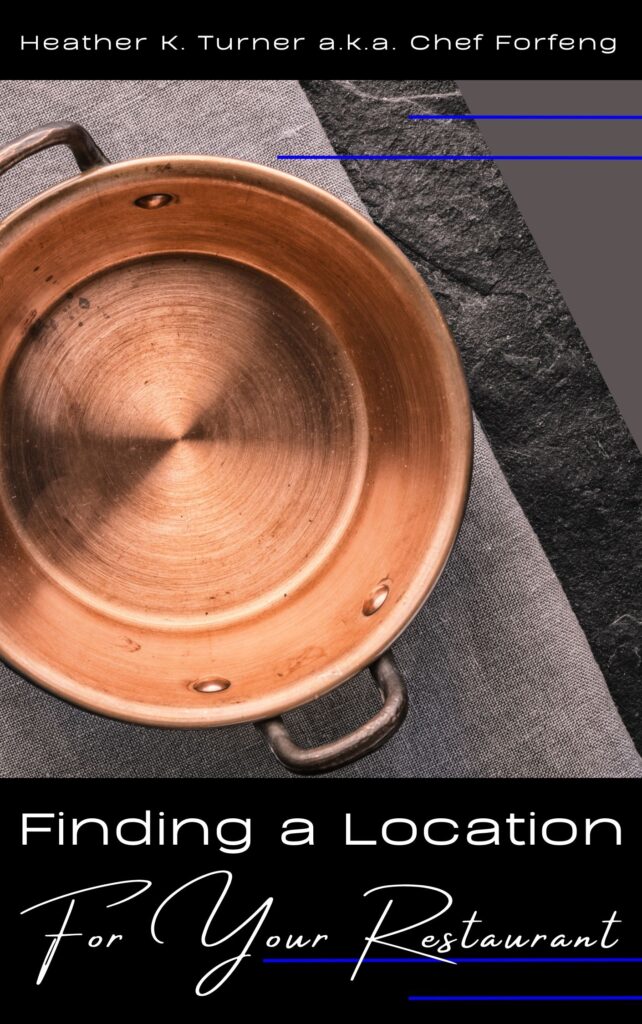by Heather T. | Aug 9, 2019 | Bed and Breakfasts, Lodging, Opinion
 Yes, this is a bit of a rant and I won’t apologize for it because this makes me quite angry, actually, it totally fries me. I work with REAL B&Bs, and yes we do encourage B&Bs to list on Airbnb, know and utilize thy frenemy so to speak. It takes less of a commission then the OTAs (Booking.com, Expedia, etc.) among other things. A REAL B&B is one that is licensed, insured and yes inspected (at least in the US) to serve breakfast, many having to take Servsafe Courses as well as having many other business licenses to operate as a legitimate business.
Yes, this is a bit of a rant and I won’t apologize for it because this makes me quite angry, actually, it totally fries me. I work with REAL B&Bs, and yes we do encourage B&Bs to list on Airbnb, know and utilize thy frenemy so to speak. It takes less of a commission then the OTAs (Booking.com, Expedia, etc.) among other things. A REAL B&B is one that is licensed, insured and yes inspected (at least in the US) to serve breakfast, many having to take Servsafe Courses as well as having many other business licenses to operate as a legitimate business.
I have a Google alert set up for Bed and Breakfasts daily for new Bed and Breakfasts opening, B&Bs in the news, new ideas on specials and packages that I can suggest to other B&Bs, B&Bs closing, a write up about them and other things B&B related. Pretty much every damn day in my alerts, I get at least one “New B&B opening in XXX”, “Bed and Breakfast offers Unique Package to Visitors”, “Bed and Breakfast Burns to the Ground, people barely escape,” “B&B fights new zoning rules”, “Man dies at B&B when using swing, branch falls and kills him,” “Kitten B&B open in New Jersey” and on and on. I have to admit that the last one was super cute but I digress. All of these headlines are NOT about REAL B&Bs, they are about Airbnbs, which many journalists synonymously interchange these words throughout the articles as if it were the same thing.
I have nothing personally against Airbnb or the average person running a small-scale Airbnb, but the industry I work with, REAL B&Bs, are most definitely affected by it. I know way too many B&Bs that have gone out of business because they can’t compete with market and lodging saturation from local Airbnbs.
Why would someone stay at a REAL B&B if they can stay at an Airbnb for cheaper? AH HA, So they think anyway. If one adds up the costs of staying at an Airbnb, plus Airbnb fees, plus cleaning fees, it is generally comparable to what the local B&B costs for the same type of room, but a real B&Bs costs already include those cleaning fees and amenities built-in, plus you get breakfast. AND if you break a leg going down those pocket stairs in the back, they do have liability insurance to cover it (Unlike most Airbnbs).
Not even going there about Airbnbs serving food, aside from the fact that you go to an Airbnb and get deathly ill, do you think their insurance will cover it? Probably not. Enough said (for now). From a long history of food service on my end, I’d get up in arms if a local place opened up its door and called itself a café, but had no inspections, no visits from “the Man”, no legal venue to serve food at. I’d have a cow.
Grandma renting out her spare room because she needs to supplement her Social Security, good for her! Parents renting out their son’s room to help pay off college tuition, I get it! Landlords taking whole rental properties off the regular housing market, in Seattle for instance, I found one apartment building with over 50 units, all renting them out on Airbnb. No, definitely no! For those out there that think Airbnb is the next best thing after sliced bread, ever have a discussion with someone looking for a long-term house rental in New Orleans or Toronto? Please do! It’s very enlightening.
I could go on about the unfairness of REAL B&Bs having to pay all of the things that a regular business has to pay, regular taxes, inspection fees, liability insurance, advertising, having to pay for business taxes including a an actual website to advertise, commissions to the OTAs, ridiculous website accessibility lawsuits, etc, but that’s not the point, it’s that many journalists are helping blur the line and spread the misconception that an Airbnb is the same exact thing as a REAL B&B.
It springs to mind a conversation I had with a friend fairly recently, she had just come back from traveling to the Hudson Valley in New York state. “Oh we stayed at this lovely Bed and Breakfast in the Upper Valley! It was so cute, the lady had a couple of small children who were really sweet and she made this fantastic sausage frittata for us the day we left”. “Which B&B?” I asked, as I know many of them there but none sprang to mind where the innkeeper’s small children were underfoot. “Oh I don’t know, she didn’t have a name, we found her on Airbnb.” It was (after looking it up because I was curious) an actual Airbnb, not a B&B, but my friend didn’t know it wasn’t the same thing, we had a rather lengthy conversation after that about the differences.
Ironically she went on to say that as they were driving back to Pennsylvania, both she and her husband got quite sick in the afternoon (remember that frittata?), she blamed it on the restaurant they ate at the night before. On average food poisoning takes two to six hours to affect someone and while eating contaminated food occasionally can take a few days to affect someone, I’d venture to guess it wasn’t the restaurant food that got her and her hubbie both having to make pit stops every ½ hour on the way home, a 5 hour trip, apparently it was not a fun drive back, can’t imagine why. No comment from the peanut gallery on that one because nothing is needed……..
And people wonder why there is so much confusion about is it an Airbnb or a REAL B&B, journalists are not helping. I am not going to cry fake news, because it’s not fake, it’s uneducated. I’ve had over a dozen conversations with journalists doing articles in the past year about B&Bs, the state of the industry and other topics, and to almost every one of them I had to explain the difference between an Airbnb and a REAL actually living and breathing B&B, and it’s sad that it takes that to have to open their eyes. For those that think I have a hard on for Airbnb, please re-read the 6th paragraph down, I don’t but I do have an issue with them not being differentiated from REAL B&Bs, and for large landlords making money at the expensive of people in tight housing markets.
Please, dear Journalists, read up on the difference between an Airbnb and a REAL B&B, talk to some Airbnbs and REAL B&Bs and educate yourself on the difference so you can help educate others, look into some of the state and regional B&B associations many of which have inspection and other standards for their members, confusing the masses is quite frankly not helping anyone and it’s certainly not helping innkeepers who can actually claim the title of innkeeper legally. ☹
by Heather T. | Apr 11, 2019 | Bed and Breakfasts, Food
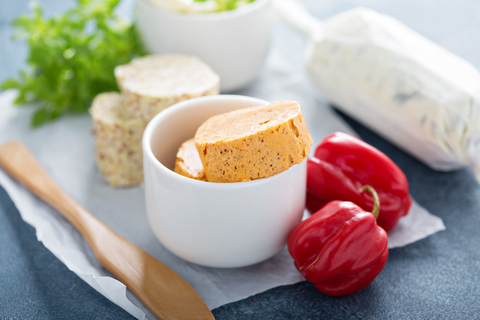
This past January one of the sessions I ran was “In the Kitchen Time Savers”, and I had a slide about compound butters. Interestingly enough, most of the questions I got at the tail end of the session were asking about the butters, I had innkeepers tracking me down after the session to ask about them and innkeepers are still emailing me, the one this morning actually is the one that prompted me to write this up.
What I have been asked about primarily is some suggestions and any tips and tricks I’ve learned over the years. So here goes……
Realistically almost anything can be made into a compound butter, aside from the usual types, you can add finely chopped smoked bacon or diced smoked salmon, lobster butter is also quite lovely, especially on top of a nice omelet or poached egg, also quite good on savory waffles as well. Smoked salmon and dill butter on a sweet potato pancake or waffle is a tasty combination. Method, soften the butter, throw into a mixer, whip, add ingredients, roll into logs, refrigerate and serve.
Using a hot knife to cut the logs is suggested (running under hot water or having a bain marie filled with hot water if you are going to cut a bunch makes it much easier to cut) be sure to wipe the blade down to remove any water first. There are cheese and butter cutters with waffle cuts that can make some fun patterns as well when cutting.
The sky and your imagination are all that hold you back. The one rule of thumb is if something tastes good with butter on it (the exception being a steak, I have tried making a compound butter with it, and it’s “interesting”) it’s generally going to taste good as a compound butter mix.
When in doubt, try micro batches. I prefer using my KitchenAid Mixer to make compounds, but if experimenting, I would use a regular small bowl and spatula to test and just do a tablespoon at a time.
Use unsalted butter to start, add Kosher Salt to taste, I prefer Diamond brand Kosher salt as other Koshers tend to be saltier and textured differently. Even with fruit butter, a pinch of salt brings the flavors out. Using iodized salt in compound butter is just gross, sorry, but it is.
While you can use plastic wrap to make the butter logs, I prefer parchment paper as it makes a more even roll, wrap well in plastic wrap after to ward off refrigerator or freezer odors.
You can set the compound butter in a large square or oval dish and use a butter curler to make individual curls as well, just be sure that any compound butters you are using with a butter curler are smooth, chunky butters like nut or chopped fruit will not curl well. I have also cut out shapes with a cookie cutter, like hearts and stars and reused the leftover butter bits for something else.
Compound butters can be cut from the log and served on a plate as an accompaniment, put in small ramekins to serve or placed directly on your entree or side, they are so versatile and I always found it fun to watch a guest in a dining room ohh and ahh over a lovely roasted pepper compound butter strategically placed on top of their stuffed sole melting slowly down over it. Where oh where was Instagram 20+ years ago?
Toasting any spices in a cast iron past before use (cool down before adding to the butter mix) brings out most flavors.
Fresh Herbs are always the way to go when making compound butters, dried herbs, even if rehydrated, never have the same flavor and the color is not a poppy as well.
I also recommend using fresh garlic and ginger, while powdered does work as well, you will get a better flavor from using fresh ingredients. If you are using a recipe, even one you have developed, taste the garlic or ginger first before adding, I suggest this about most herbs as well. One head of garlic can have a hugely different flavor from another head, that one tablespoon of chopped garlic per one pound of butter may be perfect one time, but overwhelm or underwhelm the next.
If using alcohol or liquors for the compound butters, burning off the alcohol in advance is best, let cool before adding to the mix.
If putting citrus in butters, don’t just use the juice, cut out the supremes (the segments) and chop up and use as well. Tip; using canned mandarin oranges (drain well first) makes excellent citrus butters.
For using other fruits and nuts in butter, puree or finely chop in a food processor before adding them to the whipped butter.
I try to keep most compound butters less then a week, the shelf life will vary depending on the ingredients, if you are making large batches, I’d suggest freezing them (very well wrapped to negate odors) for less than two months. Optimally a month is best. I have kept compound butters In the freezer longer with no ill effects, but again it depends on the ingredients used.
Making homemade butter is always a treat to use as a compound. Because compound butters usually don’t keep for long, the normal shelf life of homemade butter (2-3 weeks) generally doesn’t come into play. I personally love Kate’s Homemade Butter, which I think is one of the best butters out there, I prefer it above even Plugra. Please use a good butter, even if a little more expensive, the flavor makes a difference and guests notice, good ingredients are so important. It’s like cooking with cheap wine, your sauce will taste a million times better if you buy that $13.00 bottle of 19 Crimes Red Blend and use half and drink half vs the $6 cooking wine. It doesn’t have to break the bank just up the game a little.
Keep in mind when making compounds you want to think of the end results and what you intend to do with them, are they to compliment a dish you make frequently? Is it to go on every table daily to accompany muffins that may change flavor daily or scones? Experimenting is fun, but think about when you batch compound butters, is this something you are going to end up with a lot extra of, and even if frozen will it languish in the freezer until you have to throw it out to make room for something else?
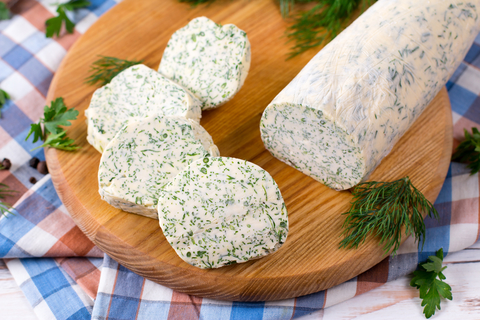
These are some of my favorites I’ve made over the years:
Sweet Butters
• Dried Blueberry and Lavender Butter
• Honey Grand Marnier Butter (also good with Toasted Walnuts or Pecans)
• Toasted Pecan and Maple Butter
• Orange Honey Butter
• Ginger and Grapefruit Butter
• Chocolate and Black Pepper Butter
• Dark Chocolate and Toasted Hazelnut Butter
• Blackberry and Sage Butter
• Mango and Ginger Butter (Mango puree works the best for this).
• Dried Cherry and Bourbon Butter
• Strawberry and Toasted Walnut Butter
• Raspberry and Chocolate Mint Butter
• Banana and Cumin Butter (with a touch of honey)
• Cinnamon Maple Butter
• Blueberry and Cardamom Butter
Sweet or Savory
• Reduced Balsamic Butter (or you can cheat and use something like Blaze’s Reduced Balsamic)
• Chocolate Balsamic Butter
• Mexican Chocolate and Chili Butter
• Honey Sriracha Butter
• Red Wine or Port Butter (always reduce the wine or port to a ¼ of its original for the best flavor, I like using Port better as it has a somewhat sweeter final taste, also yummy with some dark cocoa power dashed in)
• Blood Orange and Ginger Butter
• Macha Tea and Ginger Butter
• Roasted Apricot and Thyme Butter
• Pink Peppercorn and Grapefruit Butter
• Roasted (or Grilled) Pear and Agave Butter (Puree the pears in advance or chop very finely)
• Blueberry and Thyme Butter
• Roasted Peach and Mint Butter
• Poppyseed and Lemon Butter
• Fig and Honey Butter
Savory Butters
• Garlic and (any herb) Butter
• Lime and Cilantro Butter
• Honey Mustard and Dill Butter
• Roasted Cerignola Olive and Rosemary Butter
• Chipotle and Smoked Paprika Butter
• Jalapeno, Lime and Cilantro butter
• Lemon and Dill Butter
• Chive and Whole Grain Mustard Butter
• Caramelized Onion or Shallot Butter with Cracked Peppercorns (Peppercorn Melange/Mixed Peppercorns are good in this)
• Gooseberry and Ponzu Butter
• Grilled Eggplant and Basil Butter
• Caper and Tarragon Butter
• Roasted Pepper Butter (Red bells will give you a different flavor and color then yellows and oranges)
• Soy Sauce and Lime Butter (I like Citrus Ponzu, Lime and Ginger Butter as well)
• Smoked Tomato and Garlic Butter
• Roasted garlic (and any herb) Butter
• Black Garlic and Rosemary Butter
• Toasted Sesame and Lime Butter
• Kalamata and garlic butter (I like roasting the olives first as it gives an additional dimension to the flavor.
I could go on as there are hundreds, nay thousands of combinations out there, use your imagination and have fun!
by Heather T. | May 15, 2018 | Bed and Breakfasts, Equipment, Marketing
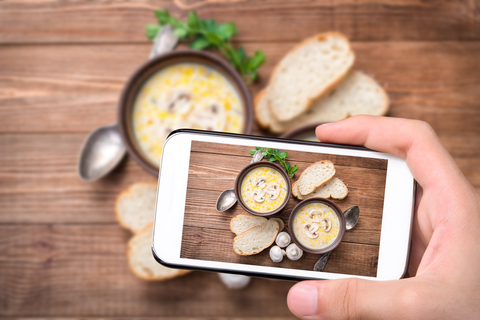
Some quick tips for innkeepers doing DIY photos for websites and social media channels.
- Experiment with height and creating different levels. Use a cutting board or other type of portable surface (cake stands, glasses, trays), etc. Adding some texture, like kitchen towels, napkins and kitchen utensils helps break things up and create visual differences between the focus of the photo (the food) and it’s surroundings.
- Use Negative Space, have spots in the photo where there is “nothing” makes for better photos. When taking closeup shots, add a little space for background or if it’s on china, for the plate to be a part of the picture, ie half a plate, a corner of the plate.
- Use a Tripod For the best photos. If using a smart phone, most full-size tripods or mini tripods now come with, or can be ordered with, smart phone mounts, you just clip your phone right into the mount and shoot away!
- Take a ton of photos, don’t take one or two, don’t take a dozen, take several dozen from various angles including straight down. What looks good on a smart phone may not good on a computer when you see it in large resolution. The more photos you take, the more of a chance you will get a couple of “keepers”.
- The food is the center point of the photo. Props are nice, but they should complement, not overwhelm the food. Taking photos on white plates is best. A colorful prop can be beautiful, but it can easily be the highlight of the picture and grab attention away from the food it’s supposed to be highlighting,
- Garnish is key. Any ingredient can be a garnish and a prop as well, a simple omelet can get “spruced up” by a little chopped parsley or some crumbled cheese and cracked pepper. Simple low prep garnishes are great for food photos. Chopped chives hold up well, as does chopped parsley without browning, crumbled/shredded cheese, chopped or whole nuts, sunflower seeds, ground pepper, chia or poppy seeds, coarse or colored sea salt, chocolate shavings or cocoa powder, coconut flakes, chili flakes, pink peppercorns, dried and fresh berries and fruit. Raid your spice cabinet!
- Do your photo editing on a computer, as mentioned prior, a photo may look great on a smartphone, it will look completely different on a big computer and you will be likely to see imperfections and things you won’t notice on a small screen.
- Build or buy a lightbox, there are a lot of inexpensive ones on the market and they are quite easy to make as well.
Tips for When Just Doing Food Photos (not photos to serve to guests, best when testing out a new recipe, what better way to utilize it when trying it out, use it to play with some photography shots!)
- Use the freshest ingredients, imperfections, even small ones, show up on camera. When specifically doing food “just” for food photos, a leaf of mint “must” be perfect, even small blemishes on fruit show up when in closeups, so heavily eyeball everything.
- Don’t cook it all the way, meat, vegetables and fruit all keep cooking (called carryover cooking) when removed from heat. To keep everything look plump and moist, take it out prior to it just being done to shoot it.
- Aerosol olive oil sprays, as well as spray bottles with room temperate water can liven up dishes and make them glisten in photos, a spray of fine misted water over fresh herbs and fruit gives it that “just picked” look.
Pro-Photographers Food Styling Tip: Capturing steam on camera is always difficult, placing cotton balls (tampons actually work the best) soaked in hot water behind a coffee or tea cup while snapping photos can give you some nice effects.
Free photo editors – lets you edit all your photos online, from one easy place.
Best Apps for Smartphones:
How to build an easy lightbox:
by Heather T. | Jan 30, 2018 | Bed and Breakfasts, Lodging, Marketing, Social Media

Last January, my how time flies! I wrote a blog about how video is hot (and it’s still getting hotter) and live streaming: Ideas for Bed and Breakfasts using Video and Live Streaming, which I would encourage B&Bs to review, because video is here to stay and will continue to advance and perhaps dominate marketing in the years to come.
I wanted to follow this up with the checklist I had made up that might help B&Bs prepare a little bit if they were going to do video to promote their B&B, or they wanted to play around with Live Streaming Video.
Checklist for doing a Live Streaming Event:
- Check Lighting. Try to avoid windows with bright sun streaming in. Turn on room lights and check for glare on camera.
- Tripods in place if needed.
- Preview movement for “in camera” objects, pre-video walkthrough or still photos.
- Sound Checks with pre-recording.
- Mute phones and cell phones if possible.
- Turn off radio and/or TV.
- Cue cards if needed for talking points.
- If doing a recipe demonstration, have your mise en place done in advance.
- If having people participate, get photo/video permissions, in writing if possible.
- Check your appearance and anyone else’s in the video in advance.
- Test your internet connection and speed.
- Video in Facebook is muted by default, so make the opening reflect your topic or reflect a brand.
- Share on as many channels as you can..
- Be cognizant that many people may be watching on smartphones, so filming with your smartphone in the vertical position is suggested.
- Time Yourself, Videos should be one to two minutes long at the most. If you are posting the videos to Youtube, keep in mind that Youtube Creator will let you edit videos as well as stitch them together.
Have you done some recent videos or live streaming events at your Bed and Breakfast that you would like to share? Please do in the comments, as I am always looking for example to show to other B&Bs!
by Heather T. | Dec 13, 2017 | Bed and Breakfasts, Blog, Equipment, Lodging, Operations
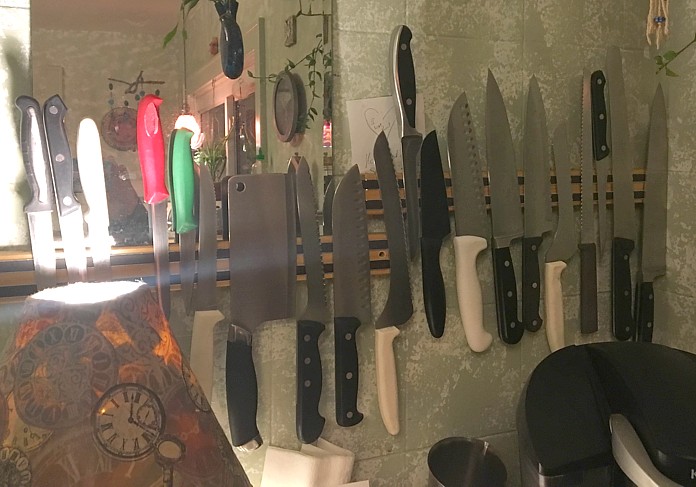
Knives have come a long way since I graduated from the Culinary Institute of America in 1992, plus there are a lot more brands out there that were not available than. Ask any professional chef or anyone else that loves cooking, whether for pleasure or for a profession, you will get a completely different answer as to the best knives, the best brands and their favorite type of knives. So this article aims to be more informational than opinion, so that the reader can choose their own with more direction.
I personally have always had (and still have) primarily Wüsthof and Henckels (J.A. Henckels) knives, and Dexter (Dexter Russell) for the ones I can badly abuse. My original knives that I used while cooking professionally, I still have almost all of them (several many inches shorter due to years of sharpening-photo above of many of them) with the exception of a boning knife that met a sad end when my husband snapped the tip off (he has since replaced it for me, such a sweet guy). A good knife lasts for a very very long time with TLC, and it’s something to keep in mind when shopping for knives, because you might go into some sticker shock looking at good quality ones, “Just HOW much is that paring knife????”. A good knife will last you decades, and can be kept in the family for many generations. I still have a Wüsthof utility (paring) knife that my Grandfather bought back in the 1920’s before he immigrated from Norway to America, and it’s still a great knife, and it still holds an edge.
Knives are a matter of preference. A lot like a car, there are certain things you want to look for when knife shopping. I would suggest adding to your knife collection slowly. Sets are great, but either you outlay a huge amount of money for a good set, of which you will realistically only use half of the knives a lot, and the others rarely, if at all, or you buy an inexpensive set and you get what you pay for, OR you can think about what you actually need, and invest in them slowly, which is what I would recommend.
Knife Storage:
Storing your knives properly is very important, if you must keep knives in a drawer, I would suggest either getting a custom rack insert for the drawer, or buying plastic knife guards for your knives.
Wood block storage is also very popular for knives; the two things I would caution users about is: don’t, under any circumstances, put your knives away wet, while wood doesn’t hold bacteria as well as plastic, if you do get any type of food contaminant or other particles in the holes you can have problems. When placing knives into the block and removing them, make sure you sheathe and unsheathe the knives with the blunt edge of the top of the knife coming into contact with the knife slot, and not the sharp side. This will help maintain sharpness.
My personal favorite for knife storage is a wall mounted magnetic strip, you can see all your knives at a glance and the risk of them dulling while coming into contact with something else is minimized. The magnets are strong, so be careful when placing your knifes on the rack, as improper placement can also cause some damage.
Some basic rules for knives:
- Always dry your knives after use.
- Never put them in the sink if dirty, or in a sink filled with water. (while this is common sense, I’ve lost count of the number of B&Bs (and sadly restaurant kitchens as well) I’ve visited that have been guilty of doing this.) While it’s not only extremely unsafe, you risk causing damage to your knives.
- After sharpening a knife, rinse well before use. I prefer washing it and than drying it, but don’t go directly from sharpening to cutting, at least wipe it down if nothing else.
- Keep your knives sharp! A dull knife will cause more damage and rip the skin if you cut yourself, vs a clean cut from a sharp knife which will heal faster and cleanly.
- Never put your good knives in the dishwasher! The wash cycle in a dishwasher vibrates silverware against your knives and contributes to dulling. It can cause delamination of some types of handles, and cause rivets to come off or loosen contributing to unsafe knives, plus most dishwashing liquids, detergents or pods contain caustics ingredients which can damage and pit your knives.
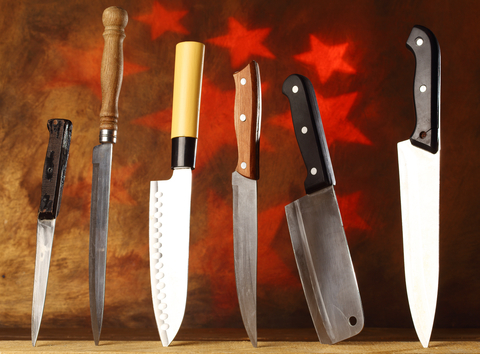
(Look at the above stock photo, look at the knife on the far right side, a rivet is missing and the handle is cracked, leading to an unsafe knife, as the partial detachment from the tang could result in the knife coming apart during use. The crack can also harbor food particles and bacteria.) You should never do this to your knives, even good quality ones can break a knife tip doing this.
Things to look for when knife buying:
The Tang: I really recommend buying full tang knives. Over many years, using other’s knives or “house” knives (what many professional kitchens have for cooks in addition to their own), I’ve found that knives with partial tangs have a short shelf life, they break and they are dangerous when the adhesive that connects the knife tang with the handle comes apart, especially if it’s being used at the time. I’ve seen many stitches as a result of injury’s caused by partial tang knives literally disintegrating while being used. I recommend meandering over to Lansky Sharpeners, who has a very good overview of knife tangs.
The Grip: the grip is a preference, what is it made of? Plastic, rubber, steel, in some cases cork and other materials. Make sure when you buy a knife, especially a Chef’s knife that you will use for chopping, the handle fits well in your hand and is comfortable, I was never a big fan of Victorinox knives (and they are great knives) because I have smaller sized hands, and the handles never felt very comfortable to me, again it’s a personal preference. Wood grips on knives tend to not hold up well under long term use. When knife shopping you may find a better price online for the knife you want and buy it there, but I’d suggest handling them first so you can see what it feels like in your hand and the balance.
Ever sharp knives: to own or not to own. I admit we have several in my house, I rarely use them but my husband does. If you want low maintenance knives, then yes these are the knives for you, but they are not “really” forever sharp. They do dull with repeated use, and you can’t re-sharpen them easily, sometimes not at all.
Riveting and Joins: When buying knives look for the joins and rivets, and see if the handle moves at all when you push the blade sideways. Good quality knives will have zero give, but many generic knives out there, while they look nice, are quite flimsy and not made for heavy duty use.
What are they made of?
Carbon Steel: this the traditional material used the most for the past few hundred years. It can hold an extremely sharp edge, but it does discolor easily. It will discolor some foods, like onions and citrus, as well as you can actually smell what seems like a chemical odor coming from it, and may leave a metallic taste. This doesn’t mean you shouldn’t use Carbon Steel with these, but it does mean that the acidity in onions and citrus can cause pitting of the blade, if you do use them, wipe the blade down every few minutes in between uses. I find if you are cutting a lot of meat or filleting fish, a carbon steel knife, I personally find, will do a better job as it’s holds an edge the best. Rubbing the blade down with a paste made from water and baking soda when you first get it (and repeat for the first few weeks) helps protect the knife and build up a good patina. Carbon steel knives will change color with use.
High Carbon Stain Free Steel: This is a relatively new alloy that combines the best features of Carbon Steel and new modern alloy metals (Chromium-Molybdenum Steel). Most modern higher end knives are made of this and it’s suggested for professional use.
Stainless Steel: this will not rust or corrode, but is a very poor choice for knives, it’s brittle and it is difficult to keep a very sharp edge on a stainless steel knife.
Ceramic Cutlery: This is a newer process made with modern age ceramics, often zirconium dioxide. Ceramic knives are substantially harder than steel knives, they will not corrode and work well for slicing vegetables, meat (boneless), fruits and bread. The downsides to ceramic, is it’s just like a plate, if it gets dropped, it can shatter or chip. Ceramic knives are not recommended for use with hard to cut items, like bones or frozen foods. While ceramic holds an edge a lot longer than carbon steel, once the edge degrades it needs a professional to re-sharpen it.
Damascus Steel: This is not “true” Damascus, that art has been lost for a long long time, these knives are basically laminated pieces of steel together, and quality can vary a huge amount depending on the maker. If you have a magnetic knife strip that can display your knives where your guests can see them, you will have the oh and ah factor, as they can be quite beautiful, but most of these knives will not outperform a regular good quality knife.
Some Quality Knife Brands:
Aritsugu http://aframestokyo.com/aritsugu.html (there are other sites out there that carry Aritsugu, the Aritsugu site itself is in Japanese).
Global http://globalknives.uk/
J.A. Henckels http://www.zwillingonline.com/
Masamoto http://www.masamotochefknives.com
Messermeister https://www.messermeister.com/
Shun https://shun.kaiusaltd.com/
Victorinox (formerly R.H. Forschner by Victorinox) https://www.victorinox.com/global/en_US/
Wüsthof http://www.wusthof.com
Honorable Mentions (great for knifes that can take some abuse, inexpensive and good for general purpose knives)
Dexter Russell http://www.dexterrussellcutlery.com/
Additional Knives:
MAC https://www.macknife.com/ (While reputedly a great knife brand, Thomas Keller and Charlie Trotter apparently love the line, the quality does seem to be there and it shows well in use.) I can’t say with certainty that this knife line will hold up well under long term use. I’ve test driven several of these, but unlike any of the above knife brands that I have used over the course of many many years, this one is a newer addition to the traditional brands. If you do decide to buy one of these, I would suggest the MTH-80 Professional over the TH-80 Chef Knives. The MTH-80 while the more expensive, is the better knife.
If anyone has any interest, I can do a follow up post on this with a suggested list of what to buy (or at least start out with) if you are just buying a bed and breakfast and need to stock the kitchen with equipment.
And an additional article with some useful tips 25 Tips And Tricks About Chef’s Knives- Every Chef Should Know.
by Heather T. | Aug 28, 2017 | Bed and Breakfasts, Lodging, Marketing, Social Media

Today I was supposed to teach a short instructional webinar on using Youtube Slideshow Creator. A very useful tool that I found out this morning (when I logged in to Youtube) that it’s being retired on September 20, 2017. Apparently, they had put out a notice (not very widely apparently) that is was going away permanently a few months ago. I did know that Youtube is revamping it’s Creator studio, which I have Beta access to, and am quite excited to see the full version of, but I was unaware of this. Caught a bit by surprise as I usually know about most social media changes way ahead of time, I am to say the least, extremely disappointed they are retiring this feature as it was very useful for B&Bs. The explanation is “that it was not widely used”, similar to Facebook retiring it’s lists feature earlier this year (and there is a workaround for them at least) the feature was a victim of the fact that hardly anyone used it, because most didn’t even know about it.
If you do want to explore Youtube slideshows, you have until the 20th to do so. Youtube says it won’t be doing away with any videos created with it prior, so if you have a few minutes and some good still photos, take advantage of it now. The slideshow feature can be replicated with other programs (I am looking into good suggestions for replacing) but access to the availability of royalty free music (that Youtube provides with the slideshow creator) is not as easily replaced.
I had done a blog in 2014 about using the slideshow option, so if you would like to play with it in the interim of the feature going away, please visit https://chefforfeng.wordpress.com/2014/02/27/how-innkeepers-can-leverage-youtubes-photo-slideshow-option/. You may need to use Firefox (recommended), Safari or Internet Explorer as Google Chrome is blocking the Flash plugin used to create the show.
If you have a current version of Powerpoint (within the last 4 years) there is an option of turning your slides (with effects) into a video that is uploadable to Youtube.
While there are literally 100s of options for programs to do slideshows and export to video ranging from $29.99 to $99.00, and many more in the higher price ranges with more bells and whistles, there are not many options out there for free.
Windows Movie Maker (PC only) (http://www.windows-movie-maker.org/) is one option that Windows users can download for free. Avid Media Composer (PC or Mac) is another, but maybe for the more technological inclined (http://www.avid.com/media-composer-first). I would very much recommend not downloading many of the other options that tout themselves as “free” without first checking them out heavily online. Many contain Spyware and Adware which can be even more malicious, and in many cases much harder to get rid of than regular viruses.
Kizoa (https://www.kizoa.com/) is one online option, but the free version limits what you can do. I have not trialed the paid version but it looks promising. There are several others online as well that offer “free” but with limitations as well. I’d recommend testing out the online ones available, with the caveat be careful what links you click on, especially if the program landing page has lots of ads on it, similar to the downloadable options for slideshow editors, be cognizant that some links may take you to malicious sites.
We are continuing to research other options for this and will post an additional post when (and sadly if) we find more comparable (free) equivalents to Youtube Slideshow Creator, Avid we had been aware of prior, and Kizoa we came across today and trial tested (and recommend to check out as a possible option) after looking at and testing about two dozen other options today.
 Yes, this is a bit of a rant and I won’t apologize for it because this makes me quite angry, actually, it totally fries me. I work with REAL B&Bs, and yes we do encourage B&Bs to list on Airbnb, know and utilize thy frenemy so to speak. It takes less of a commission then the OTAs (Booking.com, Expedia, etc.) among other things. A REAL B&B is one that is licensed, insured and yes inspected (at least in the US) to serve breakfast, many having to take Servsafe Courses as well as having many other business licenses to operate as a legitimate business.
Yes, this is a bit of a rant and I won’t apologize for it because this makes me quite angry, actually, it totally fries me. I work with REAL B&Bs, and yes we do encourage B&Bs to list on Airbnb, know and utilize thy frenemy so to speak. It takes less of a commission then the OTAs (Booking.com, Expedia, etc.) among other things. A REAL B&B is one that is licensed, insured and yes inspected (at least in the US) to serve breakfast, many having to take Servsafe Courses as well as having many other business licenses to operate as a legitimate business.








